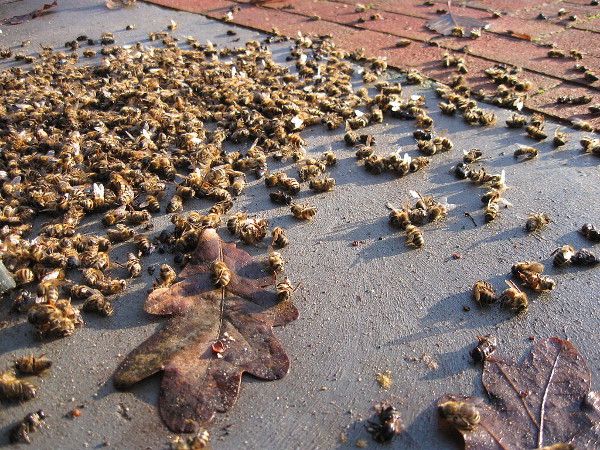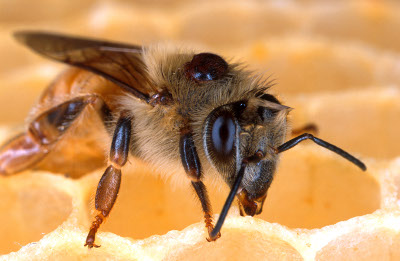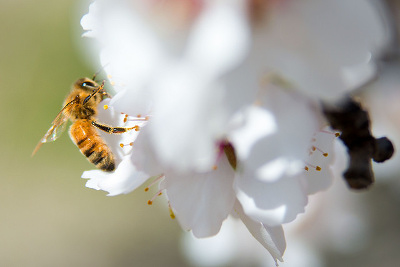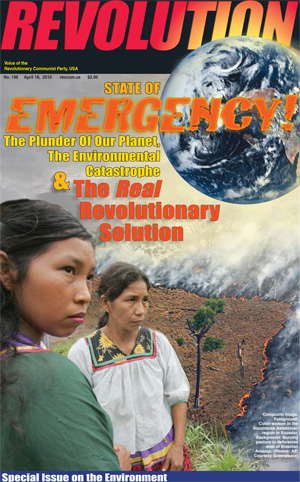From A World to Win News Service:
On the Disappearance of Bees and the Future of the Planet
November 9, 2015 | Revolution Newspaper | revcom.us
November 2, 2015. A World to Win News Service. Two years ago, between 25,000 and 50,000 bumblebees, along with honeybees and ladybugs, were found dead in a parking lot in Oregon in the U.S. Shortly after, 37 million bees were found dead in Elmwood, Ontario, in Canada.
For much of the past 10 years, beekeepers, primarily in North America and Europe, have been reporting annual hive losses of 30 percent or higher. In 2013, the British Beekeepers Association recorded the worst annual losses of honeybees in history. Almost 34 percent died. In the winter of 2013, many U.S. beekeepers experienced losses of 40 to 50 percent, or even much more—in some cases, almost total devastation.
 It is estimated that from 2007 to 2013, more than 10 million beehives were lost worldwide to Honeybee Colony Collapse Disorder. Apart from the loss of a huge number of bees, the health quality of the surviving bees is under serious threat.
It is estimated that from 2007 to 2013, more than 10 million beehives were lost worldwide to Honeybee Colony Collapse Disorder. Apart from the loss of a huge number of bees, the health quality of the surviving bees is under serious threat.
It is normal for many bees to die each winter, and mass die-offs have been regularly reported since the mid-19th century. But these recent annual statistics indicate a trend that is neither normal nor sustainable. U.S. national agricultural statistics show a honeybee decline from about 6 million hives in 1947 to 2.4 million hives in 2008, a 60 percent reduction.
Honeybee Colony Collapse Disorder, the syndrome responsible for the declining bee population, is now recognised as an urgent crisis. It is estimated that from 2007 to 2013, more than 10 million beehives were lost to CCD worldwide. Apart from the loss of a huge number of bees, the health quality of the surviving bees is under serious threat.
The most worrisome dimension of this crisis is not the possible disappearance of a tasty and nourishing item from the breakfast tables of those who can afford it. Bees are much more important for human lives and the ecosystem of the planet than honey.
Most of the world’s flowering plant species are animal pollinated. (This does not include wind-pollinated grasses such as wheat, corn and some other staple crops.) Pollinators participate in their reproduction by ensuring cross-fertilization, essential for some species, and are a major factor in ensuring genetic diversity for others.
The most common pollinators are bees, especially domesticated honeybees, as well as wild bumblebees, along with other insects and birds, and other animals. Because individual honeybees, bumblebees and some other pollinators depend on their group for survival, instead of dying off gradually, a whole community can collapse at once. For instance, in a bee colony collapse, the honey and the queen bee remain but most of the rest of the bees seem to have simply disappeared.
It is not only bees but other kinds of pollinators whose populations are declining. In the summer of 2013, the U.S. Eastern seaboard population of monarch butterflies—those orange and black icons whose complex lifestyle and long migration to Mexico each fall are one of the wonders of life—crashed to the level of 59 percent of the previous year. This is emblematic of what is happening to other pollinator species.
About two-thirds of the different kinds of plants people eat and more than a third of the total production of global food crops depend on animal pollination. One of every three bites of food eaten worldwide depends on pollinators for a successful harvest. Further, since plants are the primary food source of animals, the disappearance of a primary pollination agent, or even its reduction, could have immense consequences for our planet.
The decline of wild bees and other pollinators poses a serious threat to crop yields, too. Scientists studied the pollination of more than 40 crops in 600 fields across every populated continent and found that wild pollinators were twice as effective as honeybees in producing seed and fruit.
Half of the 109 bee species recorded in the early 20th century by the U.S. specialist Charles Robertson have been lost, and there has been serious degradation of the pollination provided by the remaining wild insects, with their ability to pollinate specific plants falling by more than half because of an increasing mismatch between when the plants flower and the period when the bees are active.
The consequence of a dying bee population impacts human beings at the highest level of our food chain, posing an enormously grave threat to our survival, since no other single animal species plays a more significant role in producing food that we humans commonly take for granted.
An example of a desperate act to compensate the loss of pollinators is the apple and pear orchards of southwest China, where wild bees have been nearly eradicated. In recent years, farmers have been forced to hand pollinate their trees, carrying pots of pollen and paintbrushes to individually pollinate flowers and using their children to climb up to the highest blossoms. But there are not enough humans in the world to pollinate all of the crops by hand.
What Is Killing the Bees?
There is a scientific consensus that acute pesticide poisoning is a major factor in the large-scale erosion of bee populations, and perhaps the most important single factor in the complex dynamic involved in CCD. Scientists have pointed especially to the family of pesticides called neonicotinoids, chemically similar to the nicotine found in tobacco. Neonicotinoids are the world’s most widely used insecticides, particularly in the U.S.
They are known to cause acute and chronic poisoning, not just of one bee, but the entire colony. Bees take the contaminated nectar and pollen from insecticide-treated plants back to the hive, creating a highly toxic living environment for all the bees. Toxicity builds up, destroying the bees’ central nervous system, causing disorientation. Ultimately the bees can neither fly nor find their way back to their nest.

European honeybee wtih Varroa mite on back.
Photo: USDA/Scott Bauer
 Pollinating a blossom in an almond orchard.
Pollinating a blossom in an almond orchard.
Photo: USDA/David Kosling
Another CCD factor are tiny parasites that infest beehives, such as Varroa mites, long a big danger to bee colonies. Since 1987 when the Varroa mite was discovered, Monsanto, Dow, Bayer and other giant chemical manufacturers in the U.S. and Europe have aggressively targeted the bee industry, selling genetically modified insecticides and herbicides as the quick and easy fix to remedy a parasitic invasion. But this may weaken the bees’ natural genetic defenses to fight off the parasite. Monsanto produced an insecticide called Bacillus Thuringeinsis from genetically altered corn that, once ingested by bees, binds to receptors within the bees’ stomach lining, causing a breakdown of the inner stomach wall which in turn makes the bee susceptible to spores and bacteria. Fungicides the bees contact in pollen also weaken their immune systems. The “cure” seems to have greatly aggravated the problem.
In the face of such a disaster and the protests of increasing numbers of concerned people, especially beekeepers and environmentalists, early in 2013 the European Food Safety Authority issued a declaration against three specific neonicotinoid pesticides that pose an acute risk to honeybees. As a result, the European Commission introduced a two-year ban on these pesticides.
In contrast, the U.S. government’s Environmental Protection Agency has been approving GMO insecticides that are believed to be responsible for killing millions of bees. With the justification of a “lack of full scientific certainty” about the relative weight of insecticides and the Varroa mite as factors in beehive collapse, the U.S. government ruled out banning their use.
However, the European ban on neonicotinoids doesn’t necessarily put the EU on the side of those concerned about bees, human lives and the environment. The ban could be very much related to competition between the European and U.S. food industries, and meant to restrict American companies’ market access. Similarly, the U.S. justification of a “lack of full scientific certainty” doesn’t necessarily mean that the U.S. government is much concerned with the accuracy of current scientific explanations. It is mainly protecting U.S. big companies in the service of its empire and world economic dominance, even though these chemicals ruin people’s lives and destroy the environment.
Despite the complexity of Colony Collapse Disorder factors, the drive for profit is a thread that runs through them. For instance, seeking maximum profit, industrialized U.S. bee farms are so eager to maximize honey yields that they often do not leave any honey for the bees to eat themselves. Eating this honey provides hormonal advantages to bees, increasing their ability to fend off parasites and viruses that have long threatened them. The high fructose corn syrup they are given to replace their own honey is believed to weaken their immune system and thus their ability to ward off disease.
Pollinating species are being lost at a much faster rate in North America and Europe, with their intensive (and therefore chemical-dependent) farming, whereas this rate is much slower in Latin America, Africa and Asia. This suggests a correlation between the use of pesticides and insecticides and the decline of pollinators. But countries with more traditional farming and much less use of pesticides and insecticides are not totally immune to this threat, which is growing everywhere.
Apart from chemicals heavily used on crop plants, and the spread of diseases and parasites as a side effect of the use of these chemicals, scientists believe climate change, deforestation and air pollution are also important factors.
Climate change has caused the loss of natural habitats, changed land use and created problems for plant and animal species facing adaptation to new habitats. Due to this climate change, in many places bees emerge earlier and earlier in the year, before plants have begun to blossom. Also, there is a relation between climate change and extreme weather, colder winters, hotter summers and droughts, all of which are factors in nutrition deficiency. In short, the increase of carbon dioxide and other greenhouse gases in the Earth’s atmosphere may be an indirect factor in bee colony collapse, but the harm it causes is as devastating to bees as it is to the bigger ecosystems and planet they are part of.
Intensive farming, including the heavy use of chemicals, and new farmlands created by deforestation, have incontestably increased both average crop yields and overall food production. But the way these gains have been achieved, because they are driven by the compulsion to maximize profits, has made the result not so much a boon to humanity as a threat to people and the planet.

This Revolution special issue focuses on the environmental emergency that now faces humanity and Earth’s ecosystems. In this issue we show:
- the dimensions of the emergency...
- the source of its causes in the capitalist system, and the impossibility of that system solving this crisis...
- a way out and way forward for humanity—a revolutionary society in which we could actually live as custodians of nature, rather than as its plunderers.
Read online....
Also available in brochure format (downloadable PDF)
Solutions?
In the face of disastrous beehive collapse, the U.S. government provided only a $3 million subsidy in order to help save an animal whose absence would bring much of global food production to a halt. Meanwhile, over the past several years the chemical industry has spent $11.2 million on a public relations initiative to prove their innocence.
The point is not that if extra cash had been provided that would have brought a real solution to the disaster. The point is to show the extreme short-sightedness not only of capitalist government policies but of the capitalist mode of production itself, where capital seeks immediate profit for the accumulation of more capital, a necessity driven by lethal competition which makes it impossible to take the fatal consequences into account.
The brutal and ugly capitalist system is continuously destroying our planet. The ecosystem is in serious danger. Thousands upon thousands of wild plants, flowers and other species have been lost forever and much greater losses are not far off. Globalization has accelerated this process.
The fate of pollinating species is not different from other wildlife—but it is key. The existing social and economic relations dominating the world have proved unable to protect our planet. In fact, they are destroying it.
A World to Win News Service is put out by A World to Win magazine, a political and theoretical review inspired by the formation of the Revolutionary Internationalist Movement, the embryonic center of the world's Marxist-Leninist-Maoist parties and organizations.
Volunteers Needed... for revcom.us and Revolution
If you like this article, subscribe, donate to and sustain Revolution newspaper.







